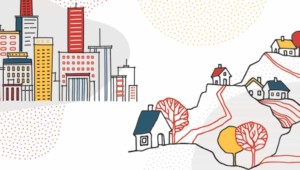The Power of Place

I’m writing this post 365 days after finishing the draft of my recently published book, The Power of Place: Authentic Learning Through Place-Based Education. You never know whether a book will feel relevant two years after you start it and a year after you finish it. But in some strange and unexpected ways, the idea of community as the classroom is more relevant today than ever before.
The Power of Place was released the week the WHO characterized COVID-19 as a pandemic. And two weeks later most schools around the world are closed. The education of a billion children was disrupted. Many are learning at home. To the extent they can, many are exploring their community. There is a lot of new place-based discovery going on.
My hope is that as the pandemic subsides, families and schools will continue to take advantage of the local assets that every community offers and that every young person will have the opportunity to experience authentic community connected project-based learning.
The Preface of Our New Book Outlines Our Aspirations:
“Well, in the ancient world, the word ‘genius’ was not so much used about individual people, it was used about places, and almost always with the world loci. Genius loci meant ‘the spirit of a place.’ And we all know what that intuitively means. We all have favorite places in the world, and it may be a seashore where you’ve got this ancient conversation between the ocean and the land and a particular geography of the way the cliffs or the beaches are formed. But it could’ve been the same in the ancient world. A little bridge crossing a stream with a pool at the back of it and a willow hanging over the pool; that place would be said to have a genius loci. But a more sophisticated understanding would [be that] it’s this weatherfront of all of these qualities that meet in that place. So I think it’s a very merciful thing to think of human beings in the same way—that is, your genius is just the way everything has met in you.” —David Whyte, The Conversational Nature of Reality (Whyte, 2016)
We have all experienced the power of place: those moments when we are fully alive; when the sights, sounds, and smells of an experience stopped us in our tracks; when learning was organic and visceral. It may be a strange new place where the culture and colors are unfamiliar and both delightful and disconcerting simultaneously. Or, it may be the mundane—an alley, field, or creek—seen with new eyes.
Place: it’s where we’re from, it’s where we’re going. Place comes in layers, it is old and new simultaneously. Place is central to human development, it is how we apprehend the world, it asks for our attention and care. If we pay attention, place has much to teach us.
We have largely stopped making use of place in formal education. All the reasons were well-intentioned but industrial: abstracted frameworks, standardized measures, and efficient facilities. The addition of mobile technology (which has the power to unlock anywhere anytime learning) is primarily used to provide useful differentiation but the addition of screen time has, in most places, reduced not increased connection to place. Formal learning experiences that leverage the power of place are now the exception and not the rule. We hope to change that.
With this book and our related work, we seek to help educators, advocates, and parents connect children with places near and far. We hope for more engagement and authenticity in education. We seek expanded access to extended community-connected challenges. We aim to leverage local assets including parks, public spaces, museums, and businesses for learning.
The Book is Organized Around Six Design Principles:
- Learner-centered: everyone experiences place differently; everyone deserves the right to build an identity rooted in place; everyone can make a difference.
- Local to global: starting local allows students to build on prior knowledge and connect to global issues.
- Inquiry-based: understanding what is in the world; staying curious and making observations.
- Design thinking: a creative problem-solving approach that allows young people to become solutionaries
- Community as classroom: every place offers something to teach; every place is part of an ecosystem; learning wherever it happens should count;
- Interdisciplinary: using project-based learning, skills and dispositions are learning through real-world learning not in isolation.
Woven through each of the six design principles are three themes: agency, equity, and community. Students from affluent communities have always experienced the power of place. Our fondest hope in writing this book is that schools and communities extend access to powerful place-based learning experiences to every child.
For more, see:
- Place-Based Education Anchors Learning in the Community
- Book Review: The Power of Place
- Geographic Literacy is a Foundational Element of Global Competency
Stay in-the-know with innovations in learning by signing up for the weekly Smart Update.
This post was originally published on ACE-ED.org.






0 Comments
Leave a Comment
Your email address will not be published. All fields are required.